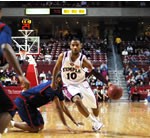
If Marquette University students weren’t on spring break this week, the school’s IT officials would have faced an internet bandwidth nightmare.
The Marquette Golden Eagles were building a lead in the second half of their first round NCAA Tournament game March 15 against the underdog Brigham Young University (BYU) Cougars when Mary Simmons, Marquette’s director of security and networks, saw that the campus’s bandwidth was “pretty much pegged,” or maxed out, even on the slowest week of the spring semester.
Whoever was left on campus, Simmons said, was streaming the game online, and IT staffers could track the sky-high use of network bandwidth.
Even with just a smattering of students and university employees on the private Milwaukee campus, Simmons had ordered the IT department to combine the school’s two internet “pipes” that have been expanded in recent years.
Even the student pipe – four times larger than the faculty pipe – wouldn’t withstand the demand while NCAA Tournament video was streamed by hundreds of people.
“I knew even the student pipe would just be too small for everyone who would be streaming this game today,” she said in an interview with eCampus News as the Golden Eagles took a commanding lead late in the game. “If the students were here this week, we might have problems.”
Providing sufficient bandwidth has been a problem faced by college campuses of every size since web video streaming became widely used in the late-2000s. The problem is compounded during March Madness, when students tune in to CBS’s online streaming site to watch their teams play on a laptop, tablet, or smart phone.
There were 26.7 million unique visitors to the NCAA March Madness Live online streaming service in 2011, according to a report from Turner Sports Media, up from only 2 million viewers in 2007. Viewers streamed more than 10 million hours of online video during last year’s NCAA Tournament.
Viewers watching March Madness games on an Apple iPhone or iPad accounted for 36 percent of all live streaming, according to the NCAA. All this while TV viewership jumped 15 percent in 2011.
Streaming video and bogging down campus networks isn’t isolated to March, of course. Colleges nationwide have reported exponential increases in video streaming thanks to Netflix, Hulu, and other services bringing TV shows and movies to laptops, mobile devices, and video game systems.
Technologists at the University of Detroit Mercy kept an eye on web traffic and bandwidth usage in the hours before the school took on the powerhouse Kansas Jayhawks in a first-round March Madness bout that marked UD’s first NCAA Tournament appearance since 1999.
The university saw a 30-percent jump in bandwidth usage during the second day of March Madness.
Edward Tracey, UD’s associate vice president for IT, said the university increased its bandwidth in December – a fortuitous network boost, it turns out.
“The timing of our entry into the tournament fits well, because we had a little room to work with,” Tracey said, adding that UD doubles its bandwidth capabilities every two years.
Tracey didn’t expect to encounter any bandwidth issues when the No. 15 seed UD men’s basketball team played the No. 2 seed Jayhawks because the game would be played at 10 p.m. Eastern time. Besides housing for some international students, UD doesn’t have a large on-campus community, so the university would be largely empty by tip-off against Kansas.
The insatiable need for more bandwidth, Tracey said, has been evident as student expectations have changed, meaning no bandwidth increase will ever be enough.
“Everyone expects everything to be taped and made available to view online,” he said. “And as the fishbowl grows bigger, the fish get bigger.”
Marquette dealt with the IT strains of March Madness in 2003, when the Golden Eagles made an underdog run to the Final Four. That year, the university upgraded the school’s hardware to handle the new traffic flooding its servers.
When Gonzaga University grabbed national attention during an unlikely 1999 tournament run, IT staffers saw visits to the school’s website triple and decided to move the web server off campus to another service provider that could handle the sudden increase.
Simmons said Marquette IT officials wouldn’t combine the campus’s internet capabilities when students return from spring break March 19. If a full complement of students maxes out the campus network with streaming of the Golden Eagles’ games, Simmons said the IT department would find a way to cope.
“If they choose to stream the basketball game, so be it,” she said. “Marquette does not block any sites at all – ever.”
- Research: Social media has negative impact on academic performance - April 2, 2020
- Number 1: Social media has negative impact on academic performance - December 31, 2014
- 6 reasons campus networks must change - September 30, 2014